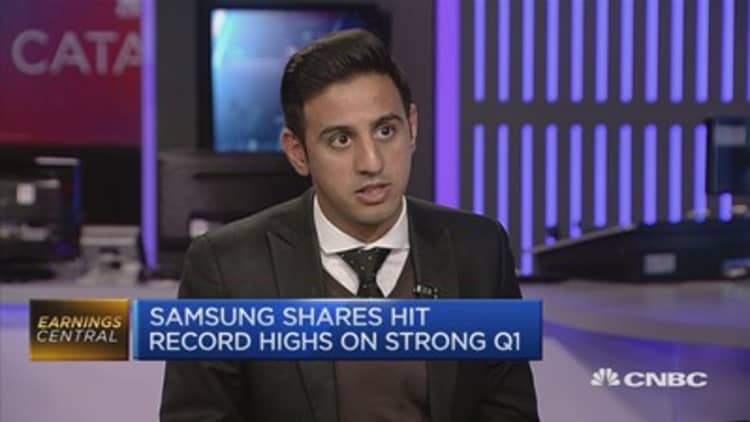
Samsung Electronics shares hit a record high on Friday after reporting strong earnings a day before, prompting analysts to boost their price target for the stock and forecast never-before-seen profit for the electronics giant.
The South Korean firm saw shares hit 2.29 million Korean won ($2,011) during trade on Friday, breaking a previous record set on Thursday, and closed at 2.23 Korean won.
It comes after Samsung reported a 48 percent year-on-year rise in its first quarter operating profit to 9.9 trillion Korean won, driven by strength in its semiconductor and display division. Samsung also announced plans to cancel existing treasury shares worth over $35 billion by 2018, accepting proposals submitted by activist hedge fund Elliott.
This boosted the company's stock price, and on Friday, a number of analysts upgraded their outlook and forecast record earnings for the full year.
Nomura upped its price target from 2.7 million Korean won to 3.3 million Korean won. This represents the prospect of 48 percent upside from Friday's close. It also said it expects operating profit of 53.2 trillion Korean won for 2017, which if achieved, would be Samsung's highest ever. The previous highest came in 2013 when the company reported full-year operating profit of 36.79 trillion Korean Won.
CW Chung, the author of Nomura's note, said profit will be driven by higher memory prices, "full-fledged earnings contribution" from Samsung's newest flagship Galaxy S8 smartphone, and rising organic light-emitting diode (OLED) display panel shipments.
Samsung has been diversifying its business in recent times to move away from reliance on smartphones and focus on high margin areas such as semiconductors and displays. It is a market leader with OLED displays, and is reportedly supplying Apple's new iPhone 8 anniversary edition.
In the first quarter, operating profit from semiconductors accounted for 63.4 percent of total profit, this was up from 39.4 percent in the same period last year. Supply constraints have pushed up memory prices which is benefiting Samsung.
As a result, Nomura is not alone in its bullish outlook:
- On Thursday, Daiwa Capital Markets raised its price target to 2.89 million Korean won from 2.7 million Korean won for Samsung, and forecast operating profit of 50.2 trillion Korean won.
- Macquarie has a price target of 3.1 million Korean won on Samsung's stock with an operating profit forecast of 52.5 trillion Korean won.
- HI Investment and Securities expects shares to reach 2.7 million Korean won and expects operating profit to hit 49.1 trillion Korean won.
The mean forecast of operating profit for the year amongst analysts polled by Reuters is 46.4 trillion Korean won with an average price target of 2.6 million Korean won. Continued strength in semiconductors, OLED Shipments and mobile is likely to help profits. Samsung officially announced that pre-orders of the Galaxy S8 exceeded those of the S7.

"We expect earnings improvement for all business segments in 2Q17, and the strong memory price to continue," Daiwa analyst SK Kim said in the note.
"In mobile, a meaningful earnings improvement is expected from 2Q17 driven by expanding sales of GS8. According to our research, pre-sales of GS8 units in the U.S. is 20 percent higher than for GS7. In display, despite increased costs for the new OLED capacity, OLED will likely drive earnings in 2H17."
Of course, the risk remains that the smartphone market turns and it faces stiff competition from the likes of Apple, which is gearing up to release its next flagship devices.





